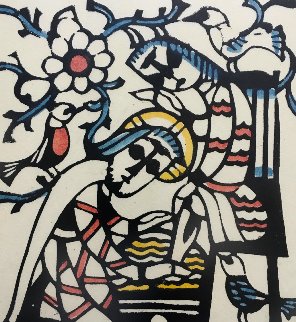


AskART lists Sadao Watanabe in 0 of its research Essays.Sadao Watanabe has 3 artist signature examples available in our database.The young Watababe worked in dyers' shops, sketching patterns and dyeing clothes. There are 0Artworks for sale on our website by galleries and art dealersGalleries and art dealers listing works of art by Sadao Watanabe as either "Wanted" or "For Sale"Research resources. AskART's database currently holds 7 auction lots for Sadao Watanabe (of which7 auction records sold and 0 are upcoming at auction.)Artist artworks for sale and wanted. Artist bioArtist auction records.
Influenced by Buddhist figure prints, Watanabe placed Biblical subjects in a Japanese context. From then on, the teacher-and-student relationship between Serizawa and Watanabe became strong and abiding.The subject matter of Watanabe's prints is exclusively the gospel rendered in the mingei (folk art) approach. A few years later, Watanabe attended a study group in which Serizawa taught his katazome technique of stencilling and dyeing, which originated in Okinawa. The event sowed the seeds of Watanabe's artistic endeavor.
The katazome method uses traditional organic and mineral pigments in a medium of soybean milk. The momigami paper was crumpled by hand, squeezed and wrinkled to give a rough quality to the prints. On the table are bottles of sake and sushi.Watanabe uses kozo paper (from mulberry tree) and momigami (kneaded paper).
Such is the mingei philosophy of art for the people and by the people. During President Lyndon Johnson's administration, Watanabe's prints were hung in the White House.Watanabe once remarked that he preferred that his prints hang in the ordinary places of life: "I would most like to see them hanging where people ordinarily gather, because Jesus brought the gospel for the people". Watanabe's Kiku (1960) was featured in the novelist James Michener's The Modern Japanese Print (1962), a book that introduced ten sosaku hanga artists to the Western audience.The Vatican Museum, the British Museum, the Museum of Modern Art in New York, the National Museum of Modern Art in Tokyo and many other leading museums in the world had exhibited Watanabe's works. The use of natural materials is one of the characteristics of mingei (folk art).In 1958, Watanabe received first prize at the Modern Japanese Print Exhibition held in New York City for The Bronze Serpent showing Moses and the people of Israel.
If you areA dealer or museum not currently registered, pleaseClick here to register, and then you may select your artist and submit2. For Premier Dealers and museums alreadyRegistered with askART your best approach is to log in, choose the artist (onceHe/she is in your list of artists), and submit your biography there. We welcome your involvement!1. Heeding the Voice of Heaven, Sadao Watanabe, Biblical Stencil Prints, Brauer Museum of Art, 2010, Valparaiso.//en.wikipedia.org/wiki/Sadao_Watanabe_%28artist%29Please note: Artists not classified as American in our database may have limited biographical data compared to the extensive information about American artists.Creating biographies or improving upon them is a work in progress, and we welcome information from our knowledgeable viewers.If you feel you have worthwhile information you would like to contribute, the following means of submission is the most efficient. Watanabe, Sadao (2000), Printing the Word: the Art of Watanabe Sadao, New York: American Bible Society. Watanabe, Sadao Takenaka, Masao (1986), Biblical Prints, Tokyo: Shinkyo Shuppansha.
(Optional:Cite number of pages and yes/no if there are color images.) For magazineArticles, cite title of article, author, title of publication, date, and page Required: What are the sources for yourInformation? For books, list title, author, date of publication. This is how many of the biographiesPlease include in your biography answers to asMany of the following questions as possible:What are the subjects and styles (and other distinctiveCharacteristics) for which the artist’s work is best known?Is the artist identified with any particular art movements, orWhere, when, and under whom did the artist receive education andCan you provide all relevant personal backgroundIn which Art Organizations was the artist a member?Can you provide a list of all major museum and artistAssociation exhibitions? ( excluding commercial art galleries).What awards or other recognition did the artist win?What museums (name, city, and state) currently holdWorks by the artist in their permanent collections? Other persons, seeingYour entry, often add to the data. Our editors are trained toDelete any hype or advertising verbiage such as “most famous,”“internationally renowned,” “extraordinarily beautiful works.”If you do not know a great deal about the artist,Answer as many of the following questions as you can. If you do not know a great deal about theArtist, but have noteworthy information to share, we would welcome you to sendIs rewarding for all of us to see artists' files grow, and others may be eagerPlease introduce your information as follows: "The following biographicalInformation has been provided by Jane Doe, the niece of the artist."Dealers and Museums will be automatically credited with a link to theirJust the facts, please.


 0 kommentar(er)
0 kommentar(er)
